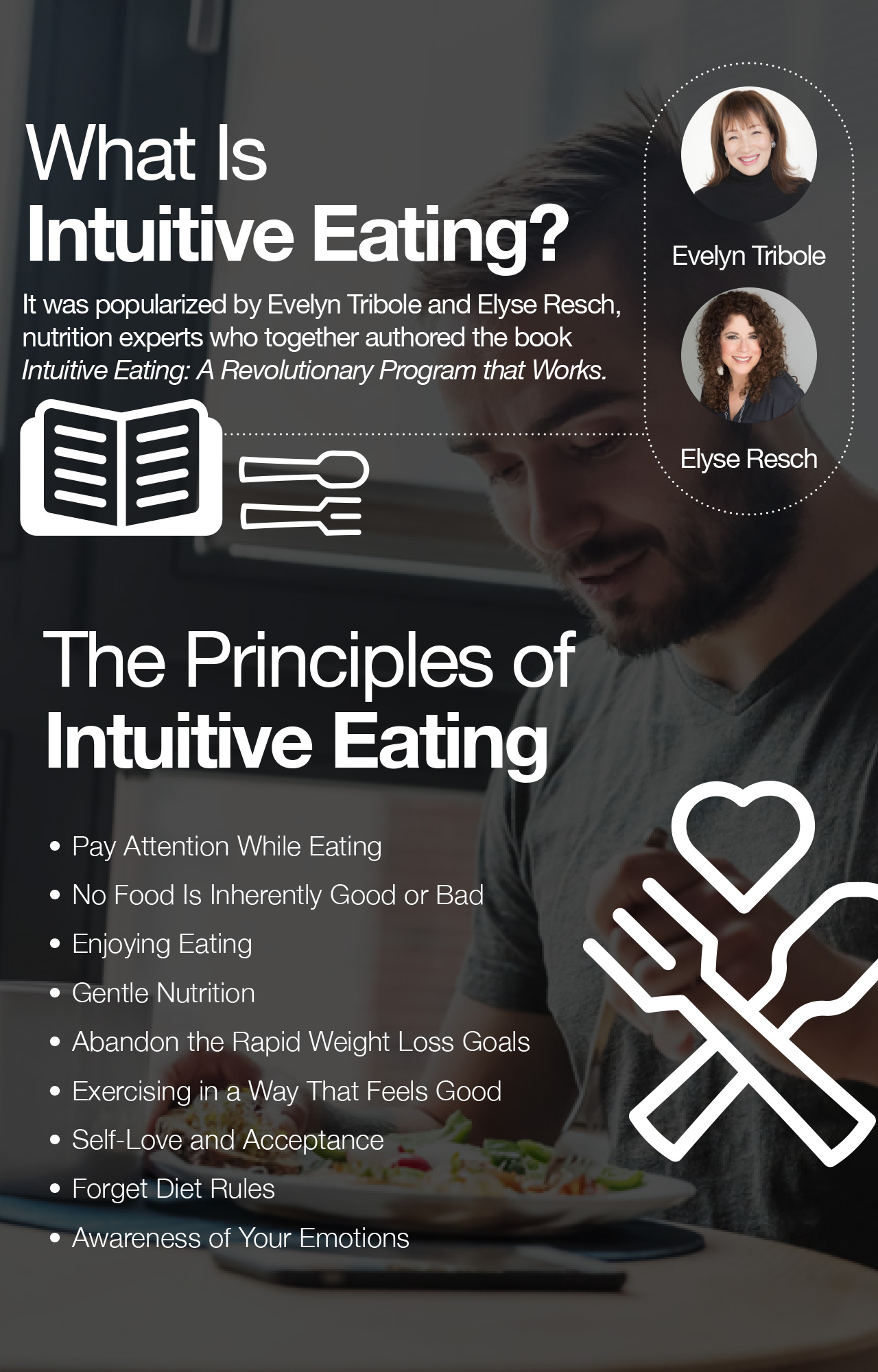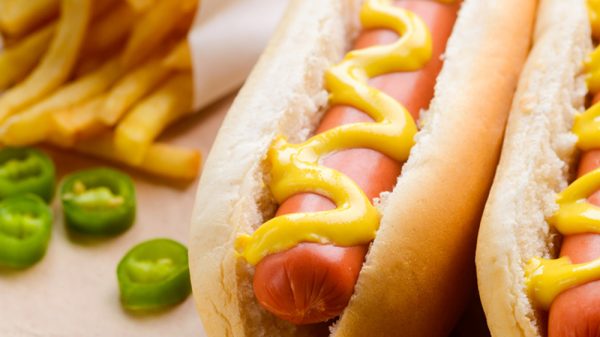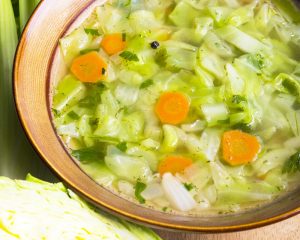Society tells us that the only way to maintain good health and a healthy weight is to follow some kind of diet. Many of us spend much of our lives trying different fad diets, cutting out food groups, restricting our food intake, and fighting food cravings. The messages throughout media culture tell us that if we don’t have a tumultuous or tense relationship with food, then we’re doing it wrong. But what if this idea is all backward? What if our bodies actually know how to nourish themselves, and all we have to do is listen to our bodies through a method called intuitive eating?
It turns out that intuitive eating is actually a great way to support your health in a balanced way. Read on to find out more about how to apply intuitive eating principles to your life.
What Exactly Is Intuitive Eating?
The intuitive eating concept was popularized by Evelyn Tribole and Elyse Resch, nutrition experts who together authored the book Intuitive Eating: A Revolutionary Program that Works.
Let’s dig into what this concept means. Intuitive eating can be thought of as the very opposite of a diet and it’s based on the idea that our bodies are programmed to know what and when to eat. Because eating is a fundamental part of existence, we do not need restrictive rules and fad diets to maintain health and well-being. In fact, these rules and diets are detrimental, and intuitive eating can more effectively and sustainably support physical and mental health.
The Principles of Intuitive Eating
According to Tribole and Resch, intuitive eating encompasses 10 key principles. Here is an interpretation of the principles laid out by Tribole and Resch that are fundamental to adopting an intuitive eating mindset.
Pay Attention While Eating
Between juggling work and household responsibilities, it is sometimes all we can do to shovel down a quick meal while on the go. Intuitive eating patterns encourage taking time to enjoy meals, whenever possible. Taking your time while eating allows you to enjoy the meal or snack while also sensing your body’s cues for hunger and satiety.
No Food Is Inherently Good or Bad
According to intuitive eating, all food is just that – food. Tribole and Resch encourage people to silence the food police, described as the voice inside your head that designates foods as either right or wrong, good or bad.
Enjoying Eating
Diet culture tends to ignore the fact that human beings are programmed to enjoy eating! On a biochemical level, eating triggers a reward response and dopamine release, which encourages the behavior of eating. Humans are hard-wired that way to ensure that we consume food regularly to support all of the body’s functions.
Intuitive eating celebrates eating as an enjoyable activity that isn’t something to fight against or obsessively control.
Gentle Nutrition
Gentle nutrition is a concept that stresses the importance of enjoying tasty food and nourishing the body. A key part of this is that it’s possible to do both.
Abandon the Rapid Weight Loss Goals
Rapid weight loss is not only unsustainable but also unhealthy. Fast weight loss is usually the result of extreme calorie restriction and fad dieting. Losing weight quickly can result in loss of muscle mass and metabolic damage. If you want to lose weight, it’s best to do so in a healthy, sustainable way that provides your body with the energy and nutrients it needs to function optimally.
Exercising in a Way That Feels Good
There is no room for “punishing” your body with exercise when adopting intuitive eating. Just like eating, moving your body is intended to make you feel rejuvenated and should be naturally incorporated into your daily routine. Try different forms of physical activity to see what feels good for you. Different forms of movement may feel better for different people. For example, some prefer a brisk walk, while others prefer playing an active game or doing a workout class at the gym.
Self-Love and Acceptance
A major part of intuitive eating is practicing self-love and acceptance of your body, just the way it is. Intuitive eating encourages health and wellness both mentally and physically, without glorifying a certain body mass index (BMI) or weight. Each one of us has a unique body shape, and accepting and loving ourselves for this is an important step in the intuitive eating journey. Eating intuitively is also designed to support where our body naturally wants to be.
Forget Diet Rules
If you’ve followed fad diets, you’re probably familiar with a vast array of rules that restricts calories or completely eliminates foods like gluten, eggs, dairy, meat, fat, sugar, and even certain fruits, vegetables, and nuts. A restrictive diet approach is not only unhealthy but also impossible to keep up with. Once we break a “rule,” we feel like we have failed, which can have a detrimental impact on mental and emotional well-being. These strict rules can also have a rebound effect; restricting calories or food groups leaves us feeling deprived, increasing the risk of binge eating and developing disordered eating habits.
It’s crucial to recognize that there are no rules in intuitive eating. Instead, this concept encourages getting familiar with your body and understanding how much and what kinds of food it needs. Intuitive eating is a holistic approach that stresses the importance of supporting a healthy body and a healthy mind.
Awareness of Your Emotions
It’s important to pay attention to your emotions surrounding food. How do you feel when you eat a satisfying meal that is nutrient-dense and full of flavor? Compare this to how you feel when you eat a restrictive meal because it’s what diet culture tells you to do.
Another important piece of the puzzle is recognizing that we all experience a range of emotions, sometimes all within the same day. Feelings of sadness, frustration, anger, joy, happiness, and contentedness are all part of the human experience. Be patient and kind to yourself when you’re feeling down, nourish yourself with good food, and practice nurturing forms of self-care. Being supportive of yourself can help cut back on emotional eating and disconnect binge eating from emotional fluctuations.
How Can You Apply These Ideas to Your Daily Life?
If you have a history of dieting, switching to an intuitive eating mindset can be challenging. Here are a few small steps you can take towards adopting an intuitive eating mindset.
Eating Slowly and Mindfully
Eating slowly gives your body and mind time to listen to cues indicating hunger or fullness. When eating, strive to practice mindful eating. As you are eating your food, take note of colors, textures, and flavors, and aim to savor each bite. You could also take short pauses in between servings, to allow yourself time to sense whether you are satiated or whether your body wants more food.
Allow Yourself to Eat All Foods
If you’re used to the diet mentality, it can take time to wrap your mind around the idea that although some foods are much more nutritious than others, all foods are ok to consume. In general, eating intuitively takes into account all food groups and provides a balance of micronutrients and macronutrients. You can start by increasing the variety of foods in your diet, even if this means just incorporating small portions of some foods. However, slowly adding all foods to your diet will help you realize that eating a slice of cake, in the context of a varied and nutrient-dense diet, does not sabotage your diet.
Limit Time on Social Media
Social media is a breeding ground for unhealthy ideologies associated with diet culture. IN fact, higher social media usage is correlated with a higher risk of eating disorders. “What I eat in a day” posts and diet advice from influencers can reinforce unhealthy eating behaviors and disordered eating patterns. Influencers often spread unsupported or unhealthy diet practices like detoxing, extreme fasting, or calorie restriction with the promise of health and weight loss. Visually, we are also susceptible to thinking that following certain diet rules will help us look like the carefully curated feed of retouched and posed images. However, this is simply not reality. Limiting our time on social media as well as only following pages that make us feel happy can support our mental health while helping us restructure our view of food and achieve an intuitive eating mindset.
Avoid Using Moralizing Language
It might take time to dissolve ingrained views about certain foods being “good” or “bad.” It might take months or longer to unlearn these views and to look at French fries without a guttural reaction to the “forbidden” food. However, you can start with small steps, like catching yourself when you describe and sort foods with words like “bad,” “treat,” “good,” and “clean.” Over time, you will begin to embrace that there are no foods that are off-limits.
What Intuitive Eating Is NOT
Let’s also clarify what intuitive eating isn’t. Intuitive eating is not another diet plan that will help you achieve your goals. Adopting an intuitive eating mindset does not mean that you eat whatever you think you feel like at the moment, at all times. For example, just because sweets taste good to us doesn’t mean we should consume several trays of brownies throughout the day. Instead, intuitive eating is really about listening to your body, getting in touch with hunger cues, and observing what foods make you feel energized and happy.
What a Day of Intuitive Eating Might Look Like
It’s difficult to provide an example of a typical day of intuitive eating, since each person’s individual choices will vary greatly, depending on their needs. However, here we go through sample food choices and internal dialogue that one may have when eating intuitively. These food ideas are only examples and are intended to show that intuitive eating can take several forms.
Breakfast
Intuitive fasting is a recent fad in diet culture that often encourages people to put off breakfast for as long as possible. However, unless you truly aren’t hungry in the morning (as some people aren’t), there is no reason why you should skip breakfast. If you’re hungry, it’s important to eat. There are endless types of meals that intuitive eaters may reach for at breakfast time. Maybe a veggie omelet with whole-grain toast sounds good to one person, while dinner leftovers sound good to another.
Others may feel energized by pairing a pastry with their coffee for breakfast, and maybe eating it with some nuts or yogurt to help increase the satisfaction factor. Others may also prefer a lighter breakfast such as a fruit smoothie, with soymilk, flaxseeds, and whey protein or another high-quality supplement that provides optimal ratios of essential amino acids.
Lunch
If you’re in the middle of a busy workday, you might grab a quick lunch that you know makes you feel satisfied so that you have fuel to power you through the afternoon. A satiating lunch may look like a sandwich on a rye roll with mozzarella cheese, tomato, arugula, and pesto, with a side of fruit salad. Going out to lunch with colleagues? Maybe you look at the menu and the chicken caesar salad or cheeseburger is calling your name. Intuitive eating guidelines would encourage you to choose what nourishes your body and mind.
Dinner
Your preferences for dinner will likely vary based on the foods you’ve eaten throughout the day. If you’ve had larger meals for breakfast and lunch, you may find that you aren’t quite as hungry for a big dinner. If you’ve had lighter meals throughout the day, you may be leaning towards a more substantial dinner. Either way, it’s crucial to listen to your body. Maybe a heavier dinner includes whole-grain pasta, chicken breast, wilted spinach, and marinara sauce. A lighter dinner may look like a green salad with tomatoes, cucumber, sweet potato, and baked salmon.
The Intuitive Eating Take on Desserts
Craving something sweet after dinner? Don’t ignore your craving. If you feel like it and it makes you happy, enjoy a serving of ice cream, fruit, or cereal after dinner. Keep in mind that eating what feels good to your body and mind is much healthier than trying to exert hyper-control over every small thing that you put in your mouth.
Snacks
If you find yourself hungry in between meals, it’s an effective intuitive eating strategy to tend to that hunger so you keep your energy levels up throughout the day. Try filling snacks like a banana with peanut butter, nuts with dried fruit, salad with shredded chicken, or Greek yogurt with blueberries. Only have time to grab a protein bar on the go or a muffin at the closet cafe? Don’t sweat it! These adaptations and working with what you have available and what feels good are the keys to successfully practicing intuitive eating.
Benefits of Intuitive Eating
Adopting an intuitive eating mindset allows you much more freedom and flexibility when it comes to your eating habits. Intuitive eating can help you re-establish a healthy relationship with food by simplifying food to what it is: energy for the body. Here are a few positive effects that may result from intuitive eating:
- Less obsessive behaviors surrounding foods: Intuitively eating ingrains a sense of trust and content surrounding food, which can eliminate the bother of worrying about food and counting calories. Intuitive eating can bring you peace of mind.
- Higher self-esteem: Body acceptance and self-love combined with allowing yourself to enjoy eating can support higher self-esteem and a positive body image. Intuitively eating can help you feel at peace and comfortable in your own skin.
- More energy: Without restricting food quantity and types of food, you can properly fuel your body. You may find that intuitively eating provides you with more energy throughout the day.
- Healthy weight for your body type: By following intuitive eating, it’s possible that you may naturally gain weight or lose weight, depending on what your body needs. Intuitively eating may help you reach a healthy body weight.
Things to Keep in Mind
If you’re thinking about changing your diet in any way, it’s always a good idea to consult a registered dietitian or nutritionist (RDN). A dietitian is able to take into account your specific needs and health conditions, helping you to make food choices and plans that are tailored to your needs.
It’s also a good idea to consult your physician about any dietary adjustments you should make to best support your health. Individuals with certain health conditions like fatty liver disease, type 2 diabetes, PCOS, high blood pressure, and chronic kidney disease may need to make certain nutritional adjustments to manage these conditions. It is possible to fuse intuitive eating with any dietary guidelines you should follow for health reasons.
Summary: What to Know About Intuitive Eating
Intuitive eating is an anti-diet ideology that suggests that our bodies know how to eat, and adopting an intuitive eating mindset is the way that we are designed to eat. Intuitive eating supports your health both mentally and physically, while also eliminating harmful restrictions and unhealthy ideas surrounding dietary habits.
























